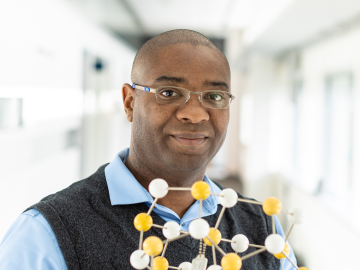
Filter News
Area of Research
- Advanced Manufacturing (1)
- Biology and Environment (27)
- Clean Energy (35)
- Climate and Environmental Systems (1)
- Computational Engineering (1)
- Computer Science (2)
- Fusion and Fission (8)
- Fusion Energy (2)
- Isotopes (6)
- Materials (60)
- Materials Characterization (2)
- Materials for Computing (5)
- Materials Under Extremes (1)
- National Security (12)
- Neutron Science (19)
- Nuclear Science and Technology (3)
- Quantum information Science (1)
- Supercomputing (42)
News Type
News Topics
- (-) Biomedical (17)
- (-) Clean Water (1)
- (-) Cybersecurity (17)
- (-) Environment (36)
- (-) Fusion (14)
- (-) Isotopes (18)
- (-) Materials (59)
- (-) Microscopy (16)
- (-) Quantum Science (26)
- (-) Summit (20)
- 3-D Printing/Advanced Manufacturing (44)
- Advanced Reactors (10)
- Artificial Intelligence (29)
- Big Data (8)
- Bioenergy (24)
- Biology (22)
- Biotechnology (7)
- Buildings (13)
- Chemical Sciences (29)
- Climate Change (22)
- Composites (9)
- Computer Science (57)
- Coronavirus (17)
- Critical Materials (11)
- Decarbonization (19)
- Education (3)
- Element Discovery (1)
- Energy Storage (41)
- Exascale Computing (9)
- Fossil Energy (1)
- Frontier (14)
- Grid (15)
- High-Performance Computing (26)
- ITER (2)
- Machine Learning (13)
- Materials Science (50)
- Mercury (2)
- Microelectronics (1)
- Molten Salt (2)
- Nanotechnology (26)
- National Security (18)
- Net Zero (3)
- Neutron Science (49)
- Nuclear Energy (26)
- Partnerships (27)
- Physics (24)
- Polymers (12)
- Quantum Computing (9)
- Renewable Energy (1)
- Security (11)
- Simulation (8)
- Space Exploration (3)
- Statistics (2)
- Sustainable Energy (31)
- Transformational Challenge Reactor (4)
- Transportation (25)
Media Contacts

Valentino “Tino” Cooper, a scientist at ORNL, has been appointed to DOE’s Basic Energy Sciences Advisory Committee for a three-year term. Cooper’s research elucidates the fundamental understanding of advanced materials for next-generation energy and information technologies.

Andrew Lupini, a scientist and inventor at ORNL, has been elected Fellow of the Microscopy Society of America.

Marm Dixit, a Weinberg Distinguished Staff Fellow at ORNL has received the 2023 Rosalind Franklin Young Investigator Award.

Researchers at ORNL have developed a machine-learning inspired software package that provides end-to-end image analysis of electron and scanning probe microscopy images.

Ho Nyung Lee, a condensed matter physicist at the Department of Energy’s Oak Ridge National Laboratory, has been elected a Fellow of the Materials Research Society.

Mickey Wade has been named associate laboratory director for the Fusion and Fission Energy and Science Directorate at the Department of Energy’s Oak Ridge National Laboratory, effective April 1.

A technology developed at ORNL and used by the U.S. Naval Information Warfare Systems Command, or NAVWAR, to test the capabilities of commercial security tools has been licensed to cybersecurity firm Penguin Mustache to create its Evasive.ai platform. The company was founded by the technology’s creator, former ORNL scientist Jared M. Smith, and his business partner, entrepreneur Brandon Bruce.

Oak Ridge National Laboratory scientists set out to address one of the biggest uncertainties about how carbon-rich permafrost will respond to gradual sinking of the land surface as temperatures rise.

Zheng Gai, a senior staff scientist at ORNL’s Center for Nanophase Materials Sciences, has been selected as editor-in-chief of the Spin Crossover and Spintronics section of Magnetochemistry.

A quest to understand how Sphagnum mosses facilitate the storage of vast amounts of carbon in peatlands led scientists to a surprising discovery: the plants have sex-based differences that appear to impact the carbon-storing process.


